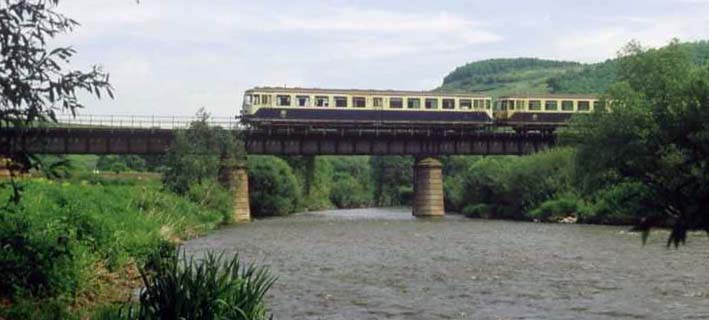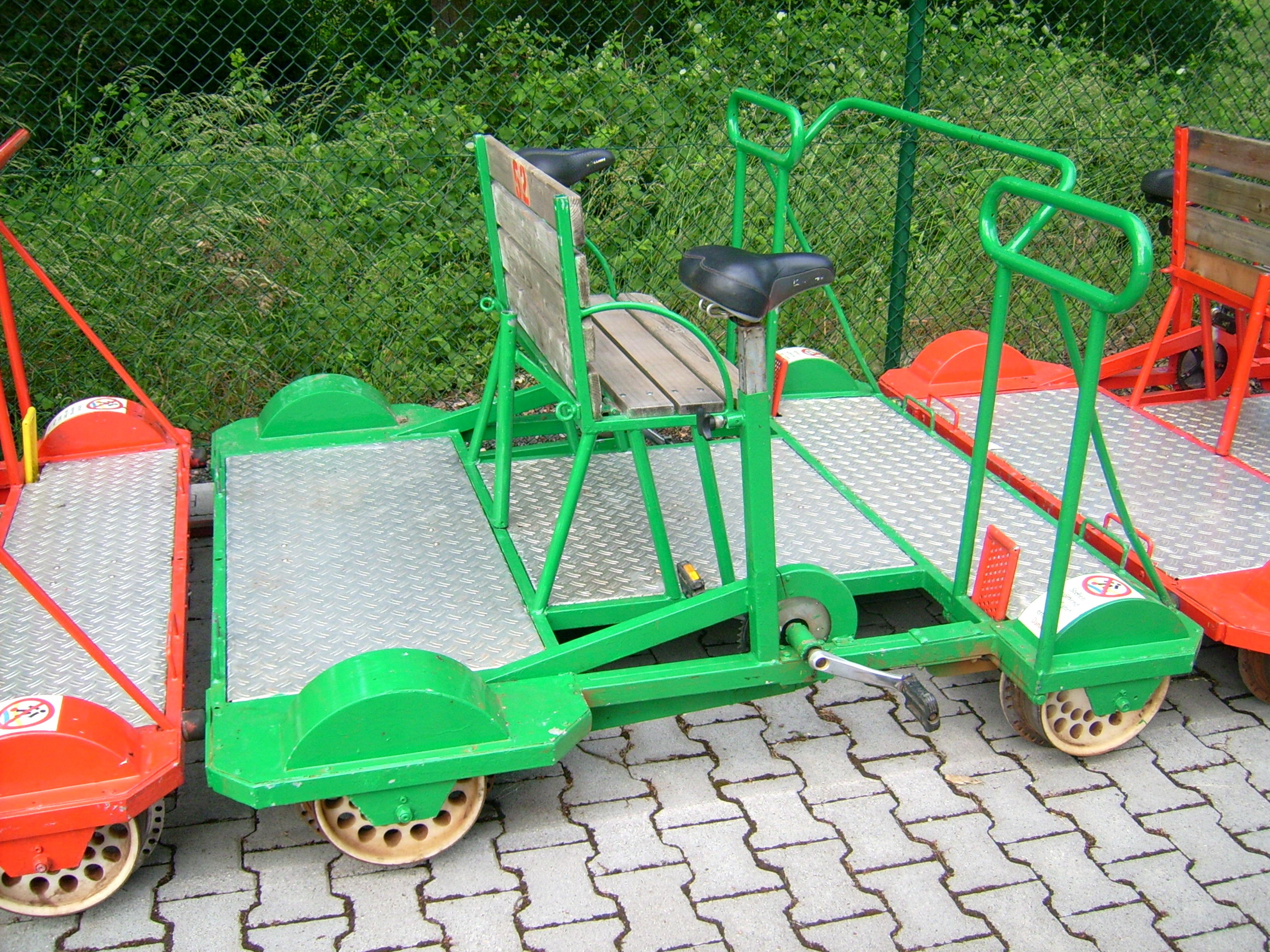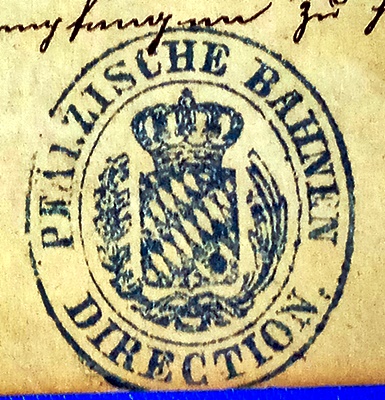|
Staudernheim Station
Staudernheim station is a through station, located 35.3 km from Bingen on the Nahe Valley Railway (Bingen–Saarbrücken), in Staudernheim in the district of Bad Kreuznach in the German state of Rhineland-Palatinate. It was opened with this line on 15 December 1859 and was the first and only station in the Meisenheim exclave of the Landgraviate of Hesse-Homburg, which was absorbed by Prussia in 1866. The station is located in the network area of the ''Rhein-Nahe-Nahverkehrsverbund'' (Rhine-Nahe Transport Association, RNN) and it is in fare zone 420. Its address is Bahnhofstraße 1. Location The station is not far from the left bank of the Nahe. Residential areas extend to its north and south. It has barrier-free access. The Nahe Valley Railway runs through the municipality in an east-west direction approximately parallel to the Nahe river on its north side. The Glan Valley Railway, which has been disused since 1996, comes from the south at first in a wide arc around the D ... [...More Info...] [...Related Items...] OR: [Wikipedia] [Google] [Baidu] |
DB Class ETA 150
The accumulator cars of Class ETA 150 (Class 515 from 1968) were German railbuses used extensively by Deutsche Bundesbahn (DB) for 40 years. The railcars were very comfortable to travel in because they were quiet (despite the typical whine of their DC motors), rode well on the rails owing to the weight of the batteries, and were pollution-free (no smoke or fumes). They ran on both main and branch lines. They were very popular with passengers, who nicknamed them ''Akkublitz'' (''Battery Lightning''), ''Säurebomber'' (''Acid Bombers''), ''Steckdosen-InterCity'' (''Socket InterCitys''), ''Taschenlampen-Express'' (''Pocket Torch Express''), or ''Biene Maja'' (''Maya the Bee'' – because of the sound they made when under way). History As a result of many years of favourable experience with this type of vehicle (the Prussian state railways had placed accumulator railcars in service as early as 1907 – these would later become Deutsche Reichsbahn's Class ETA&nb ... [...More Info...] [...Related Items...] OR: [Wikipedia] [Google] [Baidu] |
Disibodenberg
Disibodenberg today Disibodenberg ruins Disibodenberg ruins Disibodenberg picture Disibodenberg is a monastery ruin in Rhineland-Palatinate, Germany. It was founded by Saint Disibod. Hildegard of Bingen, who wrote Disibod's biography "Vita Sancti Disibodi", lived in Disibodenberg for 39 years. In 640, Disibod came as a missionary from Ireland to Francia. After working for 10 years in Vosges and Ardennes, he arrived near Odernheim am Glan and started teaching there. After his death, the monastery was founded. The Normans and the Hungarians plundered and destroyed the site several times, but Archbishop Willigis Willigis ( la, Willigisus; german: Willigis, Willegis; 940 – 23 February 1011 AD) was Archbishop of Mainz from 975 until his death as well as archchancellor of the Holy Roman Empire. Life Willigus was born in the Duchy of Saxony, possibly at ... of Mainz rebuilt the church and monastery in the 10th century. It was home to famed saint Hildegard Von Bingen throughou ... [...More Info...] [...Related Items...] OR: [Wikipedia] [Google] [Baidu] |
Regional-Express
In Germany, Luxembourg and Austria, the Regional-Express (RE, or in Austria: REX) is a type of regional train. It is similar to a semi-fast train, with average speed at about 70–90 km/h (top speed often 160 km/h) as it calls at fewer stations than '' Regionalbahn'' or S-Bahn trains, but stops more often than ''InterCity'' services. Operations The first Regional-Express services were operated by DB Regio, though since the liberalisation of the German rail market (''Bahnreform'') in the 1990s many operators have received franchise rights on lines from the federal states. Some private operators currently operate trains that are similar to a Regional-Express service, but have decided to use their own names for the sake of brand awareness instead. Regional-Express services are carried out with a variety of vehicles such as DMUs (of Class 612), EMUs (of Class 425 or 426) or, most commonly, electric or diesel locomotives with double-deck cars, the latter often wi ... [...More Info...] [...Related Items...] OR: [Wikipedia] [Google] [Baidu] |
Steam Railcar
A steam railcar, steam motor car (US), or Railmotor (UK) is a railcar that is self powered by a steam engine. The first steam railcar was an experimental unit designed and built in 1847 by James Samuel and William Bridges Adams in Britain. In 1848 they made the Fairfield steam carriage that they sold to the Bristol & Exeter Railway, who used it for two years on a branch line. Origins The first steam railcar was designed by James Samuel, the Eastern Counties Railway Locomotive Engineer, built by William Bridges Adams in 1847, and trialled between Shoreditch and Cambridge on 23 October 1847. An experimental unit, long with a small vertical boiler and passenger accommodation was a bench seat around a box at the back. The following year Samuel and Adams built the Fairfield steam carriage. This was much larger, long, and built with an open third class section and a closed second class section. After trials in 1848, it was sold to the Bristol & Exeter Railway and ran for two years ... [...More Info...] [...Related Items...] OR: [Wikipedia] [Google] [Baidu] |
Allgemeine Zeitung (Mainz)
''Allgemeine Zeitung'' is a German regional daily newspaper, published in Mainz, the capital of Rhineland-Palatinate Rhineland-Palatinate ( , ; german: link=no, Rheinland-Pfalz ; lb, Rheinland-Pfalz ; pfl, Rhoilond-Palz) is a western state of Germany. It covers and has about 4.05 million residents. It is the ninth largest and sixth most populous of the .... Founded in 1850, it is now part of the , published by . History The paper was founded in 1850 as the ''Täglicher Straßenanzeiger'' (daily street advertisement). From 1854 a redaction developed political, business, cultural and local news. The name was changed to ''Mainzer Anzeiger''. After World War I, the paper developed to a regionally read daily. The publication house was destroyed in the Air raid on 27 February 1945. In the fall of 1945, a paper was founded named ''Neuer Mainzer Anzeiger'', changed once more in May 1947 to ''Allgemeine Zeitung''.Frank Schmidt-Wyk: ''Journalisten unter Dampf'' (in German), in ... [...More Info...] [...Related Items...] OR: [Wikipedia] [Google] [Baidu] |
Altenglan
Altenglan is an ''Ortsgemeinde'' – a municipality belonging to a ''Verbandsgemeinde'', a kind of collective municipality – in the Kusel district in Rhineland-Palatinate, Germany. It belongs to the ''Verbandsgemeinde'' of Kusel-Altenglan. Altenglan is a recognized tourism community. Also, named after the municipality is the Altenglan Formation, a lithostratigraphic entity, and by extension, so is ''Altenglanerpeton'', a microsaur whose fossil remains were found therein. Geography Location The municipality lies in the uplands in the Western Palatinate on the river Glan, which is the village's namesake, at an elevation in the valley of some 200 m above sea level, although the elevations within municipal limits reach almost 400 m (Bistersberg 387 m on the Glan's left bank; Kalmet 390 m on the Glan's right bank), and on the slopes of the Potzberg within the formerly self-administering municipality of Mühlbach almost 500 m. Altenglan lies roughly 5 ... [...More Info...] [...Related Items...] OR: [Wikipedia] [Google] [Baidu] |
Bad Münster Am Stein Station
Bad Münster am Stein station is a station at a railway junction in Bad Münster am Stein-Ebernburg, a district of Bad Kreuznach in the German state of Rhineland-Palatinate. The station building, dating from about 1910, is protected as a monument. It is classified by Deutsche Bahn as a category 4 station. The station is located in the network of the ''Rhein-Nahe-Nahverkehrsverbund'' (Rhine-Nahe local transport association, RNN) and belongs to fare zone 401. Its address is: ''Berliner Straße 20''. The station, opened in 1859, was initially a through station on the Nahe Valley Railway (''Nahetalbahn''), which was built by the Rhine-Nahe Railway Company (''Rhein-Nahe-Bahn''). In 1871, the Alsenz Valley Railway (''Alsenztalbahn'') was opened from Hochspeyer with its northern terminus in the town then called just ''Münster''. From 1904 to 1961, it was also the north-eastern terminus of the Glan Valley Railway (''Glantalbahn''), a strategic railway running to Homburg. Location ... [...More Info...] [...Related Items...] OR: [Wikipedia] [Google] [Baidu] |
Palatinate Railway
The Palatine Railways (german: Pfälzische Eisenbahnen), often abbreviated to Palatinate Railway (''Pfalzbahn'') was the name of the railway division and administration responsible for all private railway companies in the Bavarian Palatinate from 1844 to 1908. The railway division was first located in the provincial capital of Speyer and later relocated to Ludwigshafen am Rhein. The company was inaugurated with the construction of the Palatine Ludwig Railway (''Pfälzische Ludwigsbahn'') by the eponymous railway company. On the completion of the Palatine Maximilian Railway (''Pfälzische Maximiliansbahn'') the operational headquarters and management of the Palatine Maximilian Railway Company was also incorporated. In 1862, it was joined by the Neustadt - Dürkheim Railway Company (''Neustadt-Dürkheimer Eisenbahn-Gesellschaft''). The same happened to the Palatine Northern Railway Company (''Gesellschaft der Pfälzischen Nordbahnen'') in 1870. In 1869 all the general shar ... [...More Info...] [...Related Items...] OR: [Wikipedia] [Google] [Baidu] |
Railway Turntable
In rail terminology, a railway turntable or wheelhouse is a device for turning railway rolling stock, usually locomotives, so that they can be moved back in the direction from which they came. Naturally, it is especially used in areas where economic considerations or a lack of sufficient space have served to weigh against the construction of a turnaround wye. In the case of steam locomotives, railways needed a way to turn the locomotives around for return trips as their controls were often not configured for extended periods of running in reverse and in many locomotives the top speed was lower in reverse motion. In the case of diesel locomotives, though most can be operated in either direction, they are treated as having "front ends" and "rear ends" (often determined by reference to the location of the crew cab). When operated as a single unit, the railway company often prefers, or requires, that a diesel locomotive is run "front end" first. When operated as part of a multiple ... [...More Info...] [...Related Items...] OR: [Wikipedia] [Google] [Baidu] |
Railroad Switch
A railroad switch (), turnout, or ''set ofpoints () is a mechanical installation enabling railway trains to be guided from one track to another, such as at a railway junction or where a spur or siding branches off. The most common type of switch consists of a pair of linked tapering rails, known as ''points'' (''switch rails'' or ''point blades''), lying between the diverging outer rails (the ''stock rails''). These points can be moved laterally into one of two positions to direct a train coming from the point blades toward the straight path or the diverging path. A train moving from the narrow end toward the point blades (i.e. it will be directed to one of the two paths, depending on the position of the points) is said to be executing a ''facing-point movement''. For many types of switch, a train coming from either of the converging directions will pass through the switch regardless of the position of the points, as the vehicle's wheels will force the points to move ... [...More Info...] [...Related Items...] OR: [Wikipedia] [Google] [Baidu] |
Kaiserslautern Central Station
Kaiserslautern Hauptbahnhof is a through- station in the German city of Kaiserslautern and one of seven stations in the city. It is a stop on the Rhine-Neckar S-Bahn and Deutsche Bahn’s Intercity-Express network and a hub for all the regional trains of the western Palatinate. On 10 June 2007, the ''Rhealys'' high-speed rail consortium established a service with a stop in Kaiserslautern, reducing travel time to Paris to two and a half hours. In 2003, the station building was renovated and it now houses among other things, a service point and several shops. The station provides step-free access to all platforms. The redesigned Kaiserslautern station forecourt includes a busy bus station, allowing a convenient transfer between bus and rail. Buses run to the University of Kaiserslautern, Betzenberg and the central bus interchanges at Schillerplatz and Rathaus, where there are connections to all bus routes. Prior to the closure of the Einsiedlerhof marshalling yard, Kaiserslauter ... [...More Info...] [...Related Items...] OR: [Wikipedia] [Google] [Baidu] |
Odernheim Am Glan
Odernheim am Glan is an '' Ortsgemeinde'' – a municipality belonging to a ''Verbandsgemeinde'', a kind of collective municipality – in the Bad Kreuznach district in Rhineland-Palatinate, Germany. It belongs to the ''Verbandsgemeinde'' of Bad Sobernheim, whose seat is in the like-named town. Odernheim is a winegrowing village. Geography Location Odernheim lies at the edge of the North Palatine Uplands at the mouth of the River Glan, where it empties into the River Nahe. This village, lying at the foot of the Disibodenberg, an important monastic centre in the Middle Ages, is surrounded by vineyards, forests and meadows in the southeastern part of the ''Verbandsgemeinde'' of Bad Sobernheim, and in the middle of the Nahe wine region. Among nearby towns, the ''Verbandsgemeinde'' seat of Bad Sobernheim lies 4 km to the northwest, the district seat of Bad Kreuznach 16 km to the northeast, Kirn 20 km to the west and Meisenheim 7 km to the south. Farther afiel ... [...More Info...] [...Related Items...] OR: [Wikipedia] [Google] [Baidu] |

_(2).jpg)






